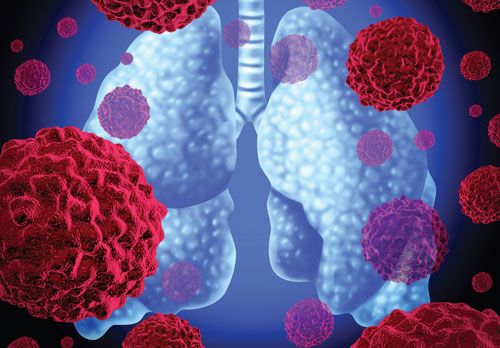Pemetrexed-Based Chemotherapy Regimens Appear More Effective in RET-Positive NSCLC
Pemetrexed-based chemotherapy regimens were more effective as treatment of patients with <em>RET</em>-rearranged non–<a>small</a> cell lung cancer compared with other regimens, according to a multicenter, retrospective study. This treatment also showed similar benefit for various <em>RET</em> fusion types, including <em>KIF5B-<a>RET </a></em>and non-<em>KIF5B-RET</em> fusions.

Pemetrexed-based chemotherapy regimens are more effective as treatment of patients withRET-rearranged nonsmall cell lung cancer (NSCLC) compared with other regimens, according to a multicenter, retrospective study. This treatment also showed similar benefit for variousRETfusion types, includingKIF5B-RETand nonKIF5B-RETfusions.
“The current preciseRETtargeted drugs are not fully utilized in clinical practice, [while] pemetrexed-based chemotherapy has some clinical benefit and pemetrexed is an alternative treatment of choice in NSCLC patients withRETrearrangements,” wrote lead author Tianle Shen of the Shanghai Chest Hospital, and colleagues. “Although our study is a retrospective study, it has a clinical significance to guide the choice of oncologists in clinical treatment.”
The objective response rate (ORR) was 50% in patients treated with pemetrexed-based chemotherapy, and the duration of complete response was 90.9%. For the other chemotherapy arms, the ORR was 44.4%, and the duration of complete response was 77.8%. The median progression-free survival (mPFS) was 9.2 months in the patients who received pemetrexed-based chemotherapy versus 5.2 months in those who received the other regimens (HR, 0.403;P= .007).
Investigators also performed an analysis ofRETfusion subtypes. Patients withKIF5B-REThad an mPFS of 7.8 months versus 11.2 months in those without the fusion; this difference was not statistically significant (HR, 0.902;P= .847).
In the second-line setting, 10 patients received pemetrexed-based chemotherapy versus 18 patients who received a different regimen. The mPFS was 4.9 months in the pemetrexed arm versus 2.8 months in the other arm, which was significantly different (HR, 0.436;P= .049). However, the mPFS was not statistically different between those with theKIF5B-RETfusion and those without, 3.4 months versus 4.9 months, respectively (HR, 1.445;P= .344).
Among 32 patients withRETrearrangements who received a pemetrexed-based regimen in either the first- or second-line setting, the PFS was not significantly different from the mPFS of patients with the KIF5B-RETfusion (7.8 months or nonKIF5B-RETfusion (7.5 months; P= .217).
Ten patients withRETrearrangements also received cabozantinib (Cabometyx) treatment, and the ORR in this group was 30%, and the DCR was 70%. In addition, the mPFS was 3.07 months, and this was not significantly different among those with the KIF5B-RETfusion (1.7 months) or the nonKIF5B-RETfusion (5.8 months; P= .002).
Among the 40 patients with NSCLC harboringRETrearrangements, 38 patients had follow-up data, which demonstrated a median overall survival (OS) of 26.4 months. OS was not significantly different between those with the KIF5B-RETfusion (26.0 months) and the nonKIF5B-RETfusion (26.4 months; P= .505).
Investigators, however, noted a trend in OS that was evident in patients withRET-rearranged disease who previously received pemetrexed-based chemotherapy (35.2 months) versus those who did not (22.6 months; HR, 0.392;P= 052). Gender (P= .752), age (P= .136), smoking history (P= .930),RETfusion types (P= .508), brain metastases during therapy (P= .055), and whether or not a patient received cabozantinib (P= .403) or pemetrexed-based chemotherapy (P= .053) did not lead to a significant difference in PFS.
A total of 62 patients with NSCLC harboringRETrearrangements were enrolled to the study with a median age of 59 years (range, 25-78). All patients had RETrearrangements. The normal rearrangements included 41 patients who had KIF5B-RET(66.1%), and 15 had CCDC6-RET(24.2%). There were also rare RETrearrangements, including 2 patients with ATR-RET, 1 with ANK3-RET, 1 with ERC1-RET, 1 withRABEP1-RET, and 1 withALOX5-RET.
Overall, 40 patients received a chemotherapy regimen in the frontline setting, which included pemetrexed/platinum (n = 19), pemetrexed alone (n = 3), paclitaxel/platinum (n = 14), and gemcitabine/platinum (n = 4). Patients received their chemotherapy regimens based on recommendations from the National Cancer Care Network guidelines. Seven of the 40 patients also received the addition of bevacizumab (Avastin) with chemotherapy.
Overall, the study authors recommend that pemetrexed-based chemotherapy regimens be considered first when selecting a chemotherapy regimen as treatment of patients with NSCLC andRETrearrangements.
“Pemetrexed had relatively limited adverse effects, and thus may be an alternative treatment of choice in NSCLC patients withRETrearrangements,” Shen et al concluded. “In addition, prospective trials with larger sample sizes are warranted to identify more effective RET0TKI drugs with lower toxicity.”
Reference:
Shen T, Pi X, Wang L, et al. Association Between RET Fusions and Efficacy of Pemetrexed-based Chemotherapy for Patients With Advanced NSCLC in China: A Multicenter Retrospective StudyClinical Lung Cancer. 2020: doi:10.1016/j.cllc.2020.02.006.
Roundtable Roundup: Lung Cancer Molecular Testing and ALK-Targeted Treatment
January 18th 2025In separate, live virtual events, Vincent K. Lam, MD, and Chul Kim, MD, MPH, discuss molecular assays and treatment options for a patient with metastatic non–small cell lung cancer (NSCLC), with participants.
Read More